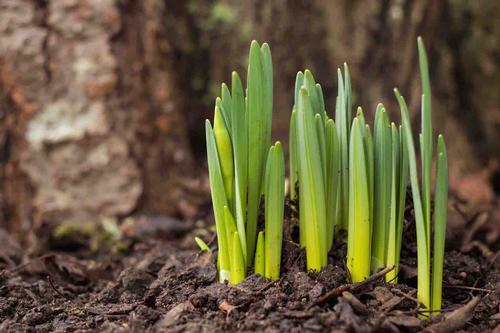
Why Well-Drained Soil is So Important
A plant needs to absorb three things from the soil: water, nutrients and oxygen. Soil quality determines how easy – or how difficult – it is for your plants to get these essentials. Here’s how well-drained soil supports healthy plant growth:
Lets Roots Breathe. Plant roots need oxygen just as much as they need water. In soil that is dense (like clay) or has been compacted (by foot traffic or machines), soil particles are pressed tightly together and most of the air has been squeezed out. In well-drained soil, there are little pockets of air between the soil particles that allow plants roots to move around with ease and find the oxygen they need to thrive.
Provides the Right Amount of Water. Plants need moisture, but too much water rots bulbs and suffocates roots. In well-drained soil, the spaces between soil particles provide channels for water movement. When puddles appear on the soil surface, it means water is unable to drain down through the soil.

Encourages Beneficial Soil Life. Earthworms, pillbugs and other soil creatures, plus billions of microbes, convert organic matter and minerals into nutrients that can be absorbed by plant roots. These organisms need to breathe and move about in the soil, which is easy for them to do if the soil is loose and well-drained.
Offers Vital Nutrients. Plants drink in nutrients by absorbing them through their roots. This means nutrients need to be dissolved in water before plants can use them. In well-drained soils, dissolved nutrients can cling to soil particles and be available to plants as they're needed.

Good Soil is a Work in Progress
If the soil in your yard and garden isn’t ideal, don’t worry. Most soils need some improvement.
As a general rule, avoid planting in areas that are soggy or occasionally have standing water. To make these areas suitable for most types of plants, you'll need to change the grade or add a curtain drain to help remove the excess moisture.
Where winters are wet, working the soil in early spring can leave you with hard clumps that are difficult to break up. Give the soil some time to dry out before you start digging. To check, squeeze and release a handful of soil. If it crumbles, it's ready to work.
Start by removing any grass or weeds that could compete with your bulbs or plants. Creating a weed-free planting area saves hours of work down the line. Next, loosen the soil with a spade or garden fork. Dig down 10 to 12” and gently lift the soil to incorporate air. Break up any clumps and then rake the area smooth.
Adding organic matter such as peat moss, compost or shredded leaves is an effective way to lighten heavy soils and improve soil fertility. These can be incorporated in either spring or fall. Mulching around plants with bark chips, pine straw or leaf mold will also improve poor soil. As these materials gradually break down, they can be mixed into the soil to improve its texture, feed soil microbes and provide essential plant nutrients.
